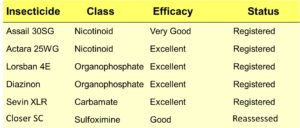Sweet Corn
European corn borer (ECB) moth catches in black light traps continue to be very low. There will be no map in this edition due to insufficient catch. There have been isolated incidents of new feeding in the far south of the state, but generally, the threat to corn should be low until the second flight begins in earnest. Once plants hit full tassel, any ECB larvae present will move downward on the stalk and re-enter the plant near the area where ears are forming. This can result in direct injury to the ear. Growers should consider an insecticide application at the full tassel stage to target ECB larvae as they migrate downward. This application can eliminate larvae that have escaped any earlier insecticide applications. [Read more…]

